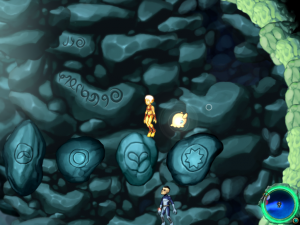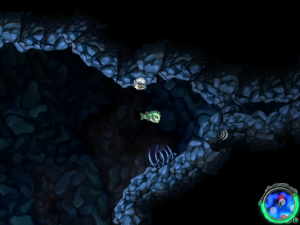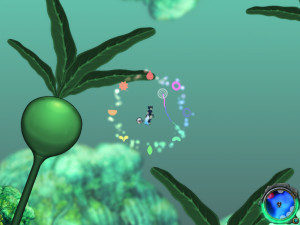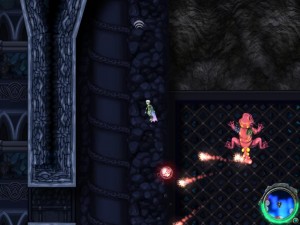Aquaria: Killing God
The nature of Aquaria‘s end boss is hinted at early on, in the cave where you learn your first song. There, you can find an evil-looking statue of a distorted face, with some kind of horns or tentacles attached. As you approach it, you hear a chuckle from a malevolent disembodied basso with good reverb, a bit like the voice of the Guardian in Ultima VII. On the wall, a word in Aquarian script identifies this being. That word: “Creator”. You’ve been fighting mad gods throughout the game, but this one is the original, the mad god to end all mad gods — or rather, to start them. It seems that all the dead races referenced in the game are his creations, experiments that ran their course and were discarded, leaving nothing but forsaken monsters. Even in your final battle with him, his signature attack consists of spawning new creations for you to fight, including shadowy versions of Naija herself.
Like any self-respecting god, what Creator really wants is worship. But in asking for it, he comes off as a creepy stalker: “You will love me forever”, etc., with a strong undertone of “I want you to give up all hope of ever being anything other than my abject, dehumanized plaything, and if you don’t, you are my enemy and will be destroyed, just like so many others before you”. In other words, it’s the whole “God as Abuser” concept stripped bare. But in the end, after you defeat his final form, he turns out to be no Gnostic demiurge: creator of civilizations though he may be, he’s not the creator of the world. He’s just a traumatized child given way too much power. As the last of his own people, his sincere motivation for everything he’s done is simple loneliness — which is very explicitly Naija’s motivation as well. Is she less of a monster than him? She’s more sympathetic at the moment, but if the root cause of his evil is that he’s too powerful, what are we to say about someone who goes around killing gods?
But I suppose she’s at least got the loneliness kicked. Towards the middle of the game, she meets a human named Li. She immediately falls in love with him, and grants him water-breathing ability with a kiss — it’s one of those stylized folk-tale romances, as unrealistic as their unmoving faces. I didn’t mention Li before because he honestly didn’t seem all that important. He follows you around and provides a certain amount of supporting fire, like a second pet, but otherwise just kind of fades into the background. Sometimes it took me a while to notice that he had gotten stuck somewhere and wasn’t with me any more. Towards the end, you learn a song that lets you use him for a powerful and complicated attack sequence, but once you have that, the game has to come up with excuses to not let you use it, and so Li suddenly develops a habit of getting captured and requiring rescue, like a gender-swapped Princess Peach. In the end, it’s the jealous Creator’s insistence on separating them that goads Naija into direct confrontation. (Well, that and the fact that his inner sanctum is the only place in the entire world that she hasn’t explored yet.)
The approach to the end involves a fair amount of adventure-game-like puzzle-solving, where you’re thrown into unique situations and have to apply the correct song to make progress. The final boss fight itself continues this. It’s a multi-stage affair, going through four distinct phases, some with multiple sub-phases. The most affecting part, I felt, was the bit where Creator morphs into a one-eyed insect-like thing that scuttles off into the darkness, then repeatedly flees from your light like a cockroach. If there’s one thing scarier than a monstrosity, it’s a half-glimpsed monstrosity that doesn’t want you to see it. I’ll probably have more to say about that when I post about the next game.
 Comments(0)
Comments(0)


